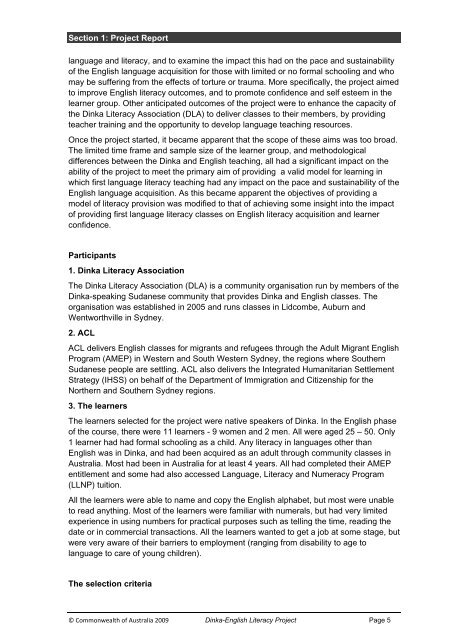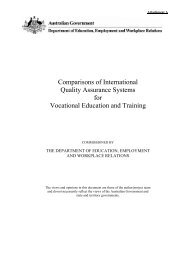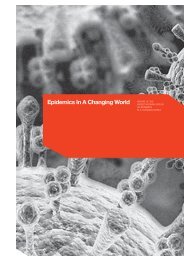First Language (Dinka) Literacy as a Foundation for English ...
First Language (Dinka) Literacy as a Foundation for English ...
First Language (Dinka) Literacy as a Foundation for English ...
You also want an ePaper? Increase the reach of your titles
YUMPU automatically turns print PDFs into web optimized ePapers that Google loves.
Section 1: Project Report<br />
language and literacy, and to examine the impact this had on the pace and sustainability<br />
of the <strong>English</strong> language acquisition <strong>for</strong> those with limited or no <strong>for</strong>mal schooling and who<br />
may be suffering from the effects of torture or trauma. More specifically, the project aimed<br />
to improve <strong>English</strong> literacy outcomes, and to promote confidence and self esteem in the<br />
learner group. Other anticipated outcomes of the project were to enhance the capacity of<br />
the <strong>Dinka</strong> <strong>Literacy</strong> Association (DLA) to deliver cl<strong>as</strong>ses to their members, by providing<br />
teacher training and the opportunity to develop language teaching resources.<br />
Once the project started, it became apparent that the scope of these aims w<strong>as</strong> too broad.<br />
The limited time frame and sample size of the learner group, and methodological<br />
differences between the <strong>Dinka</strong> and <strong>English</strong> teaching, all had a significant impact on the<br />
ability of the project to meet the primary aim of providing a valid model <strong>for</strong> learning in<br />
which first language literacy teaching had any impact on the pace and sustainability of the<br />
<strong>English</strong> language acquisition. As this became apparent the objectives of providing a<br />
model of literacy provision w<strong>as</strong> modified to that of achieving some insight into the impact<br />
of providing first language literacy cl<strong>as</strong>ses on <strong>English</strong> literacy acquisition and learner<br />
confidence.<br />
Participants<br />
1. <strong>Dinka</strong> <strong>Literacy</strong> Association<br />
The <strong>Dinka</strong> <strong>Literacy</strong> Association (DLA) is a community organisation run by members of the<br />
<strong>Dinka</strong>-speaking Sudanese community that provides <strong>Dinka</strong> and <strong>English</strong> cl<strong>as</strong>ses. The<br />
organisation w<strong>as</strong> established in 2005 and runs cl<strong>as</strong>ses in Lidcombe, Auburn and<br />
Wentworthville in Sydney.<br />
2. ACL<br />
ACL delivers <strong>English</strong> cl<strong>as</strong>ses <strong>for</strong> migrants and refugees through the Adult Migrant <strong>English</strong><br />
Program (AMEP) in Western and South Western Sydney, the regions where Southern<br />
Sudanese people are settling. ACL also delivers the Integrated Humanitarian Settlement<br />
Strategy (IHSS) on behalf of the Department of Immigration and Citizenship <strong>for</strong> the<br />
Northern and Southern Sydney regions.<br />
3. The learners<br />
The learners selected <strong>for</strong> the project were native speakers of <strong>Dinka</strong>. In the <strong>English</strong> ph<strong>as</strong>e<br />
of the course, there were 11 learners - 9 women and 2 men. All were aged 25 – 50. Only<br />
1 learner had had <strong>for</strong>mal schooling <strong>as</strong> a child. Any literacy in languages other than<br />
<strong>English</strong> w<strong>as</strong> in <strong>Dinka</strong>, and had been acquired <strong>as</strong> an adult through community cl<strong>as</strong>ses in<br />
Australia. Most had been in Australia <strong>for</strong> at le<strong>as</strong>t 4 years. All had completed their AMEP<br />
entitlement and some had also accessed <strong>Language</strong>, <strong>Literacy</strong> and Numeracy Program<br />
(LLNP) tuition.<br />
All the learners were able to name and copy the <strong>English</strong> alphabet, but most were unable<br />
to read anything. Most of the learners were familiar with numerals, but had very limited<br />
experience in using numbers <strong>for</strong> practical purposes such <strong>as</strong> telling the time, reading the<br />
date or in commercial transactions. All the learners wanted to get a job at some stage, but<br />
were very aware of their barriers to employment (ranging from disability to age to<br />
language to care of young children).<br />
The selection criteria<br />
© Commonwealth of Australia 2009 <strong>Dinka</strong>-<strong>English</strong> <strong>Literacy</strong> Project Page 5
















